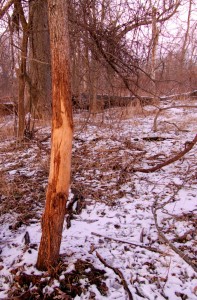 As you reflect on last deer season and think, Man, what a killer or bummer year, guess what? It’s time to get out there and start scouting again. Snooping around for old sign gives you a leg up on the bucks you’ll hunt 7 or 8 months from now.
As you reflect on last deer season and think, Man, what a killer or bummer year, guess what? It’s time to get out there and start scouting again. Snooping around for old sign gives you a leg up on the bucks you’ll hunt 7 or 8 months from now.
Core of the Matter
When scouting in late summer and early fall, the times when most hunters do it, you want to cover lots of ground, but you’re leery of laying down scent and jumping the deer you’ll hunt in a few weeks. So you play it safe and poke around the fringes of fields, woods and thickets. Sure, you find fresh tracks and maybe some early rubs. But these are only the corner pieces of the puzzle. All sorts of stuff you know nothing about is happening inside deer core areas.
Scouting from February through April is the best way to unlock these secrets. Roam every inch of a hunting ground, not giving a flip if you spook deer. (You won’t hunt ‘em for at least half a year, so who cares?). Hit every nook and cranny of cover, searching for trails, rubs and scrapes you missed last season. Jot down all the “new” stuff you find on topographic maps and aerial photographs. Then study the charts and connect the innermost pieces of the puzzle. You’ll be way ahead of the game come October because whitetails are notoriously habitual creatures that establish the same general patterns from year to year.
Sign Reading
“Signposts” blazed by bucks 5 months ago still shine like beacons. If you run across antler-scarred trees as thick as your ankle or even your thigh, mark them with a red “X” on your maps. You’ve probably located some segment of a core area where a good buck hung out last fall. If the deer survived hunting season and isn’t struck by a car over the summer, he’ll be back. Or another buck will find and occupy the residence this autumn since it offers a nice blend of food, cover and escape trails.
Scout the core of a core area. Look for brushy knolls and ridges laced with clusters of big and small rubs—perfect spots for a buck to curl up with his back to the breeze. Get down and dirty. Sit in beds to get a “buck’s eye” view of the surrounding terrain and cover. You’ll see how a big deer hides out and peers downwind for does and predators.
In warm and moderate climates, and after snow melt up North, last fall’s scrapes are visible into early spring. Look for old scrapes and scout out around them. Note where bucks scraped and rubbed at the intersections of primary and secondary doe trails. Look for clusters of “basketball” scrapes on the fringes of doe feeding and bedding areas. Peel an eye for community scrapes the size of truck hoods, where both does and bucks deposited rut scent three or four months ago. You might even find new tracks and freshly worked lick branches, since research shows that whitetails often visit community scrapes year-round.
Advance Work
As you snoop around for old sign, look for new trees that offer strategic views of deer feeding, bedding and funnel zones. They’re easy to spot in the barren winter and early spring woods, before green up. Plan to hang tree stands there before next season. You might go ahead and saw out spots for fixed-position or climbing stands. Clip arrow lanes if necessary. This advance work will let you hang perches quickly and quietly come next fall. Make sure tree pruning is permitted on public lands.





